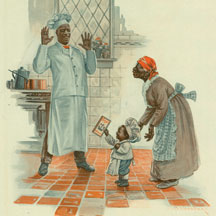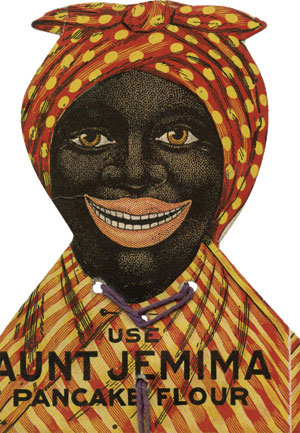In the 1880s, Chris Rutt, who had recently developed the idea of a self-rising pancake batter, attended a minstrel show that included a skit with a southern mammy character named Aunt Jemima. Rutt and his partner, Charles Underwood, decided that the mammy, dressed in an apron and bandana, would help distinguish and sell their pancake mix. When the R.T. Davis Mill Company purchased Rutt and Underwood's company, they employed a real person to portray Aunt Jemima in their marketing scheme. Nancy Green, born a slave in Kentucky in 1834, became the first "real" Aunt Jemima. She impersonated Aunt Jemima until her death in 1923.
At the 1893 World's Exposition in Chicago, Green, as Aunt Jemima, sang songs, cooked pancakes, and told romanticized stories about the Old South as a happy place for blacks and whites. Afterwards, her image was plastered on billboards nationwide, with the caption, "I'se in town, honey." In her role as Aunt Jemima, Green made appearances at countless country fairs, flea markets, food shows, and local grocery stores. By the turn of the century, Aunt Jemima, along with the Armour meat chef, were the two commercial symbols most trusted by American housewives.
A short video showing the marketing of Aunt Jemima and its impact on some peoples view of her today. Many consider Aunt Jemima as a kind, happy motherly figure who made great pancakes. Aunt Jemima, sang songs, cooked pancakes, and told romanticized stories about the Old South as a happy place for blacks and whites. But examine how these interpretations came to be and whether they were based on reality or in marketing. How many times does it take to call Aunt Jemima "Happy" before everyone
believes it? And does just saying she is "Happy" make it so?
Audio excerpts from the "Aunt Jemima Variety Show"








